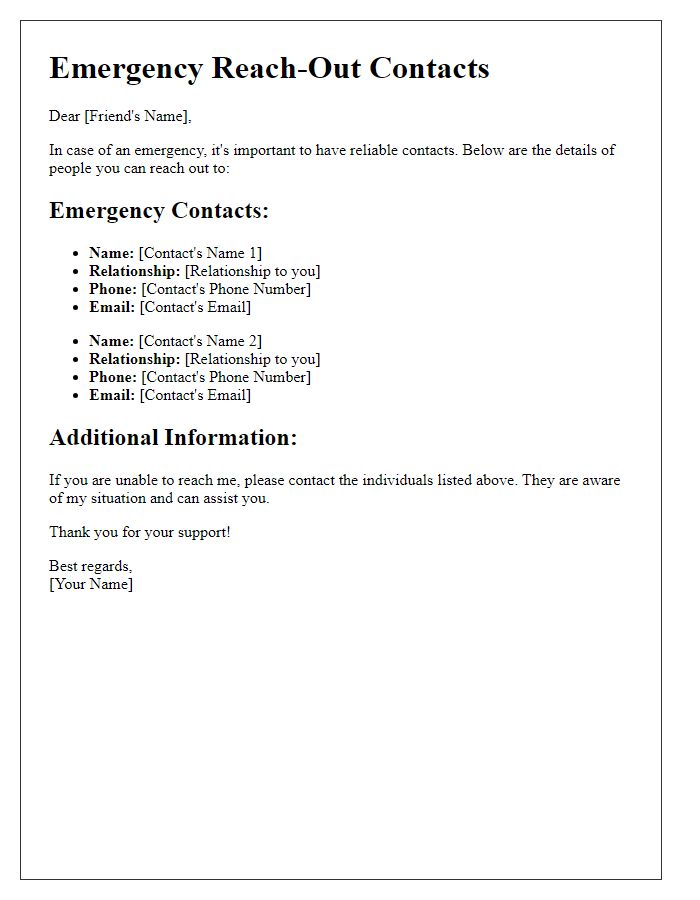When it comes to ensuring the safety and well-being of our loved ones, having a reliable emergency contact information letter is essential. This simple yet crucial document can serve as a lifeline in times of need, providing critical information to first responders and caregivers. Whether you're preparing for a family outing or just want to be proactive, knowing how to structure this letter can make all the difference. So, let's explore how to create an effective emergency contact information letter that can give you peace of mind in any situation!

Accurate contact details
Accurate contact details are critical during emergencies to ensure prompt assistance. The primary contact person should include a full name (John Smith), relationship to the individual (father), and up-to-date phone number (555-123-4567), ideally a mobile number for immediate access. Secondary contacts may encompass additional relatives or friends, designated to provide support and assistance. All contacts should also feature email addresses (johnsmith@email.com) for alternatives in communication. Additionally, physical addresses (123 Main St, Springfield, USA) are essential for emergency services to locate individuals effectively. Regular updates to this information are recommended, particularly after significant life changes, ensuring accuracy and reliability in urgent situations.
Relationship to the individual
Emergency contact information serves as a critical link during urgent situations. The relationship to the individual refers to the nature of the connection between the contact and the person in need, such as parent, sibling, spouse, or friend. This information is essential for responders to understand the level of familiarity and responsibility the contact may have. Knowing the relationship can inform decisions regarding medical consent, legal rights, and emotional support. For example, a parent might have exclusive rights regarding medical decisions for a minor, whereas a spouse might act as the primary decision-maker for an adult. Understanding these relationships enhances the effectiveness of emergency protocols and ensures appropriate care and communication.
Medical information
In medical emergencies, having accurate and accessible medical information is crucial. Important details include individual allergies, such as penicillin or shellfish, which can trigger severe reactions. Pre-existing conditions, like diabetes or asthma, require immediate attention and treatment protocols. Medication lists, including dosages and physician names, ensure proper care. Emergency contacts should consist of family members or guardians, including names, relationship, and phone numbers. Relevant health insurance details, such as provider and policy numbers, streamline access to medical services and billing. Location coordinates (latitude and longitude) can guide emergency responders swiftly, particularly in remote areas. This comprehensive medical profile plays a vital role in expediting care during critical situations.
Authorization statement
Emergency contact information is crucial during critical situations, such as medical emergencies or natural disasters. This authorization statement ensures that designated individuals, such as parents or guardians, have the legal right to act on behalf of the person in need of assistance. It may include specific names, such as John Smith and Mary Johnson, along with their relationship to the individual (e.g., father, mother). Additionally, vital details like the individual's date of birth and address must accompany the emergency contacts' information. Clear instructions outlining medical preferences and necessary interventions can enhance the effectiveness of emergency response, ensuring timely and accurate actions in urgent scenarios.
Emergency response plan
An emergency response plan is crucial for organizations to effectively manage unexpected situations like natural disasters or medical emergencies. Key components of this plan include contact information for emergency services, such as local fire departments, police stations, and hospitals. For instance, the New York Fire Department can be reached at 311, while the nearest hospital, Mount Sinai Hospital, offers emergency services 24/7 at its Manhattan location. Additionally, it is essential to maintain an updated list of internal emergency contacts, including managers and safety officers, with valid phone numbers and roles clearly outlined. Regular training and drills, tailored to specific scenarios such as earthquakes or active shooter situations, enhance preparedness. Documentation must be easily accessible, ensuring all employees can quickly find policies and procedures during a crisis.













Comments